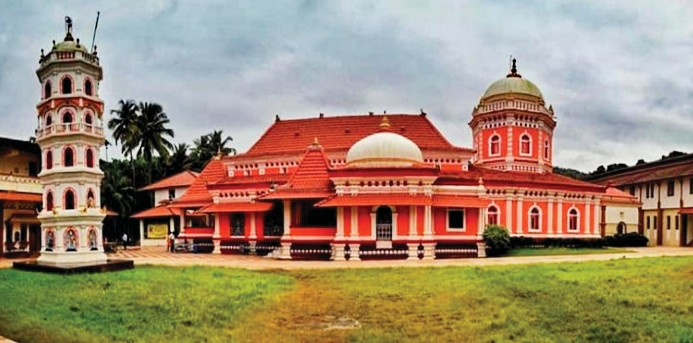For all those who believe that Goa is all about beaches, churches and gala parties, there is a lesser-known dimension to it. Ruchi Verma brings out the state’s rich Hindu heritage and culture and lists many ancient temples that dot its breath-taking landscape. Most temples are exquisite and date back to the Kadamba period in the 12th century with fascinating stories behind them.
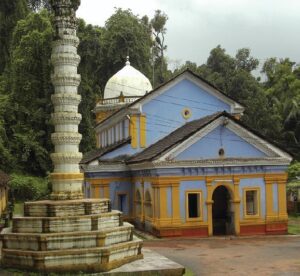 Saptakoteshwar Temple
Saptakoteshwar Temple
India’s smallest state Goa is famous for its breathtaking beaches, spectacular churches and the ‘happening’ party scene. What most are unaware of, however, is the region’s rich Hindu culture that can be seen through the innumerable exquisite temples scattered through the state’s landscape.
Hinduism is the majority religion in Goa. According to the 2011 census, in a population of 14,58,545 people, 66 per cent identified themselves as Hindu. The Goan Hindus comprise Saraswat Brahmins, Daivadnya Brahmins, Karhad Brahmins, Konkanastha Brahmins (Chitpavans),etc. Other groups include Kunbis, Gaudas, Konkan Kshatriya Chardos, Vaishya Vanis, etc.
Hindus in Goa celebrate their festivals with pomp and fervour. For example, the Yatra or the procession of Shree Mahadeva Shiva and Shree Mahadevi Shantadurga (Durga) is quite an elaborate affair where devotees from far and wide gather to celebrate.
Exquisite temple revering Lord Shiva
Goa is home to some of the most exquisite and spectacular temples in the country. They have unique features and almost always painted in bright colours, typical of the houses and structures in the Konkan region.
The Saptkoteshwar Temple at Narve in Goa is an important Shiva temple in the Konkan region. It is considered to be one of the six great sites of Shiva temples in Konkan. Narve or Naroa is located in North Goa, near Panjim, across from Divar Island.
A form of Shiva, Saptakoteshwar, was one of the chief deities and a family deity of the kings of the Kadamba dynasty that ruled around the twelfth century in the region. The Saptkoteshwar Temple was built by a king for his wife who was a Shiva devotee.
The rulers of this dynasty even used the title (Birudu) Shree Saptakotisha Ladbha Varaveera before their names as a mark of reverence. Artefacts such as gold coins, often referred to as Saptakotisha-Gadyanakas, discovered at Chandor, Gopikapatna, etc., have inscriptions that further highlight the significance of the god. The inscriptions read ‘Saptakotishvaralabdha – Varaprasada’ which means ‘with the grace of Lord Saptakotishwara’.
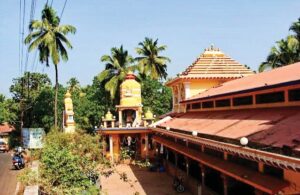 Shree Siddheshwar Temple
Shree Siddheshwar Temple
When Goa, then under Kadamba rule, was conquered by a Sultan, several temples were destroyed. For about fourteen years, the region was ruled by Bahmani Sultan Allauddin Hasan Gangu, that ended in 1367.
Finally, when the Sultan was defeated by King Harihararaya of Vijayanagar, many temples in Goa, including the Saptkoteshwar temple, were rebuilt and restored. It was only by the end of the fourteenth century that the temple was reconstructed by Madhava Mantri.
As per legend, the name Saptakoteshwar has an interesting story to its origin. Once, seven holy sages began to pray to Lord Shiva at a site where five holy rivers met the sea. They prayed for seven crore years at the end of which Lord Shiva, pleased with their dedication, granted their wishes and agreed to stay at the place in one of his incarnations. This incarnation is known as Saptakoteshwar – ‘sapt’ means seven and ‘koteshwar’ means lord of crores.
The temple is also famous for Gokulashtami celebrations that draw Goa’s hidden treasure trove of temples.
Surviving the inquisition
The temple bore the brunt of the brutal Portuguese inquisition as well when the invaders destroyed a large number of temples in Goa. In 1560, the Portuguese destroyed the Saptkoteshwar temple and, at the same site, using stones from the temple, constructed the Nossa Senhora De Candelaria
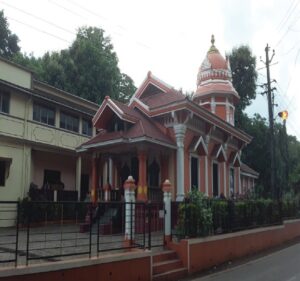 Maruti Temple in Ponda
Maruti Temple in Ponda
chapel. In fact, the Linga was used by them as a well shaft and still bears the marks made by the ropes used for drawing water at the time.
It were a few devotees who rescued the shivling and took it to nearby Bicholim area that is now in Goa’s mining belt. A man named Narayan Shenvi Suryarao took the Linga and hid it in Latambarsem where it remained for three years.
In 1668, under the aegis of Maratha ruler Chhatrapati Shivaji Maharaj, the temple was reconstructed at Narve and the Linga was reinstalled rightfully. At the site of the new temple in Narve, a stone plaque mentioning this order can be seen.
Ponda, the Antruz Mahal
The central part of Goa comprising Ponda or Fondya is referred to as ‘Antruz Mahal’ because of the presence of several famous and important Hindu temples in the area. These include the temples of Shri Manguesh (Shiva), Shri Mahalaxmi, Shri Nagesh, Shri Ganapati, Shri Mahalasa, Shri Ramnath and the Goddesses Shri Shantadurga.
Antruz Mahal, a Hindu pilgrimage destination, thousands of devotees and tourists visit every year to pay homage to god or to just explore and revel in the region’s rich cultural heritage.
As per legend, it is believed that divine energy protects the entire Ponda region. This is the reason why the zone is called the land of the divine energy of Sri Anant or ‘Anant Urja Mahal’ which has come through the generations to be known as ‘Antruz Mahal’.
Maruti Temple in Ponda is dedicated to Lord Hanuman. Rich in architectural heritage, the temple stands testimony to the zone’s rich history. On Tuesdays, the day dedicated to Lord Hanuman, there is huge fanfare and festivities as devotees gather in large numbers to pray to their favourite god.
Nagesh Temple located in Donshiwado, Ponda was established in 1413 AD. It is dedicated to Nagueshi or Nagesh, an incarnation of Lord Shiva. One of the oldest temples in Goa, this temple is also one of the few that stands in its original place and was not shifted out of the Velha Conquistas during the
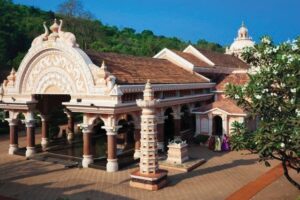 Mahalaxmi Temple in Ponda
Mahalaxmi Temple in Ponda
Portuguese rule.
The temple’s presiding deity is Shri Nagesh Maharudra and other deities are Shri Laxmi Narayan and Shri Ganapati.
Goddess of power
In Ponda’s Bandora, Mahalaxmi Temple too is visited by devotees from across borders. Mahalaxmi, who many accept as Pallavi – the patron deity – is said to have been released during Samudramanthan or the churning of the ocean by the gods (deva) and the demons (asura) to extract the nectar of immortality or ‘amrit’.
Mahalaxmi, believed to be an incarnation of Adishakti, is the goddess of power and strength. When the Saraswats arrived in Goa, they were worshipping ‘Shiva-Shakti’. The goddess representing Shakti and Linga symbolising Shiva.
The Shilahara rulers worshipped Mahalaxmi and so did kings of the Kadamba dynasty in Goa. At Bandora’s Mahalaxmi Temple, the satvik or peaceful form of the goddess wears linga on her head. Goddess Mahalaxmi’s main temple is situated in Kolhapur in Maharashtra state.
The temple comprises a dynamic silver arched doorway that leads from an oil-red hall to sanctuary. The twenty-four wooden panels here are beautifully painted displaying instances from Bhagvata Puran. The paintings are also inspired from anecdotes and life of Lord Krishna.
At this temple, the nine-day-long festival celebrating the many forms of goddess Durga – Navaratri – is celebrated grandly. Other festivals celebrated with fervour include Ram Navami, Shri Mahalakshmi Pratishthapana Day in Vaishakha and Maha Shivratri in the month of Magha.
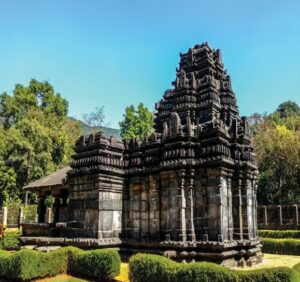 Mahadev Temple
Mahadev Temple
During Mahashivratri, when the main idol of the goddess is taken out on a chariot by the devotees on their shoulders, thousands gather to get a glimpse of their goddess.
An ancient temple
The most ancient temple in Goa is the Mahadev Temple located at Tambdi Surla at Mollem. The temple was built in Kadamba style from basalt that was carried from the Deccan plateau across mountains and then carved into the structure that can be seen today.
Owing to its location in the deep forests on the foot of the Western Ghats, the temple remains untouched. The small and beautifully-carved black basalt temple is dedicated to Lord Shiva. It’s considered to be the only specimen of Kadamba-Yadava architecture in basalt stone preserved and available in Goa.
In the temple, the linga is mounted on a pedestal inside the inner sanctum. As per a legend, a huge king cobra lives permanently in the semi-lit interiors of the structure. There is a garbhagriha, antarala and a pillared basalt Nandi mandapa.
At the centre of the mandap is a headless Nandi who is Lord Shiva’s vehicle flanked by four columns. The base of each column has carving of an elephant trampling a horse. Interestingly, elephant was the symbol of the Kadamba Kingdom.
The ceiling displays beautifully-carved Ashtoken lotus flowers that rest on the four pillars that are decorated with fine carvings of elephants and chains. The panels on the temple sides have figures of Lord Brahma, Vishnu and Shiva. As the temple is dedicated to Lord Shiva, Mahashivratri is a big festival celebrated with a lot of fervour.
Symbolising peace and harmony
Shri Shantadurga Chamundeshwari Temple is situated in Ghudo Avedem village (Quepem Taluka) in South Goa and is one of its kind. It denotes peace and harmony and the temple furthers communal harmony as well. Members of the Hindu and Christian community worship here. The deity is also called Santeri.
The temple is located on the banks of Kushawati River.
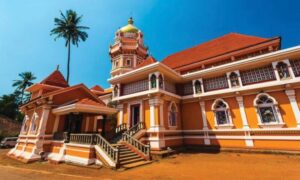 Shantadurga Temple
Shantadurga Temple
Initially, in 1560, the temple was established in Salcete Taluka in village Curtorim (Kudtari). However, owing to the inquisition and religious conversions that followed, the devotees fled the place and took their deities along.
In this case, the founders of the Kudatari temple took their deities to Shelvon and subsequently moved to Ghudo ward of Avedem village in Quepem Taluka where it was finally established in its present form.
The Shantadurga Temple is located at three places in Goa. According to legend, when a battle broke out between Lord Vishnu and Lord Shiva, Lord Brahma requested Shiva’s wife goddess Parvati to intervene. She took the form of Shantadurga (Shant means calm) and settled the fight. The deity of goddess Shantadurga is shown as holding one serpent in each hand representing Lord Vishnu and Lord Shiva.
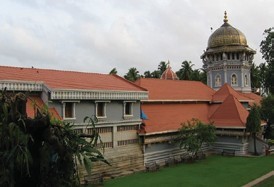 Mahalasa Narayani Temple
Mahalasa Narayani Temple
Intricate and magnificent
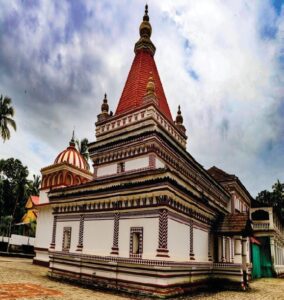 Morjai Temple
Morjai Temple
In North Goa’s Morjim area, known for its Russian tourists, lies the beautiful Shri Morjai Temple. Dedicated to goddess Shri Morjai, the temple is a unique blend of grandeur and simplicity – elegant designs and grand structure.
Shri Morjai is known to be one of the seven sisters who came and resided in different parts of Goa along with their brother, Shri Khetoba. The temple dons a unique red and white colour combination and is decorated with rare and extinct ‘Kaavi’ art friezes.
The exquisite geometric patterns that adorn the temple can also be seen on its window grills. There is a ‘Mukhmandap’ and an exterior ‘Sabhamandap’ dating to 1936.
The main festival celebrated at this temple is ‘Kalas Utsav’ which is observed once in every three, five, seven or nine years and which lasts for nearly a month. It begins from the Phalgun Shudda Panchami and is celebrated with a lot of fanfare and festivities.
At the Shri Morjai temple, several other festivals are also celebrated and these include Gudi Padwa, Dussera, annual jatra or jatra and ghodemodni.
Shri Damodar Temple Zambaulim or Shri Damodara Sansthaan is located on the banks of the Kushawati River in Sanguem near Zambaulim village. The temple is dedicated to Lord Shiva incarnated as Lord Damodar.
Before the Portuguese arrived in Goa, the deity of Lord Damodar was originally placed in a temple in Madgaon or Margao. Today, the Holy Spirit Church stands at the same site.
At the time when the Portuguese were destroying Hindu temples, the Mahajans shifted the local deities from Madgaon and took them to Zambulim. This was in 1567. These included deities of Damodar, Shri Ramnath, Mahakali, Mahesh, Laxmi-Narayan, Chamundeshwari, etc.
 Mangueshi Temple
Mangueshi Temple
Temple with tales
One of the largest and the most frequently visited temples in Goa is the Mangueshi Temple, again dedicated to Lord Shiva. This temple too, like most other in Goa, was first established in Kushasthali Cortalim, a village in Murmugao, on the banks of River Aghanashini.
In 1560, when the Portuguese attacked and started conversions in this zone, the Saraswats of Kaundinya Gotra and Vatsa Gotra shifted the Mangesh Linga to protect it. The deity was moved to Mangeshi in Priol village in Atrunja taluka. He is the kuldeva or family deity of Chitrapur Saraswat Brahmins and the Goud Saraswat Brahmins.
After the relocation, the temple has been rebuilt and renovated twice during the reign of the Maratha dynasty in the region and then one more time in the year 1890. The final renovation occurred in the year 1973. This time, a golden kalasa or golden vessel was installed on top of the tallest dome of the temple.
The original temple was a very simple structure. Later, about 150 years after the deity was moved, the new and existing temple structure was built by Maratha rulers. It were the Peshwas who donated the village of Mangeshi for the construction of the temple in 1739.
The Brahma Temple in Valpoi’s Nagargao is a must visit for those visiting Goa. According to Hindu legend, the creator of the universe, Lord Brahma was to have just one temple at Pushkar in Rajasthan. But there is this one in Goa too which not many know.
The statue in the temple dates back to the Kadamba period in 12th century. Like most structures of the period, in this temple too, the statue of Lord Brahma has been made from one black stone. The statue is tall, wears a beard and is in the form of a Trimurti i.e. Brahma, Vishnu and Mahesh, visited by
thousands of devotees from all over Goa and beyond.

